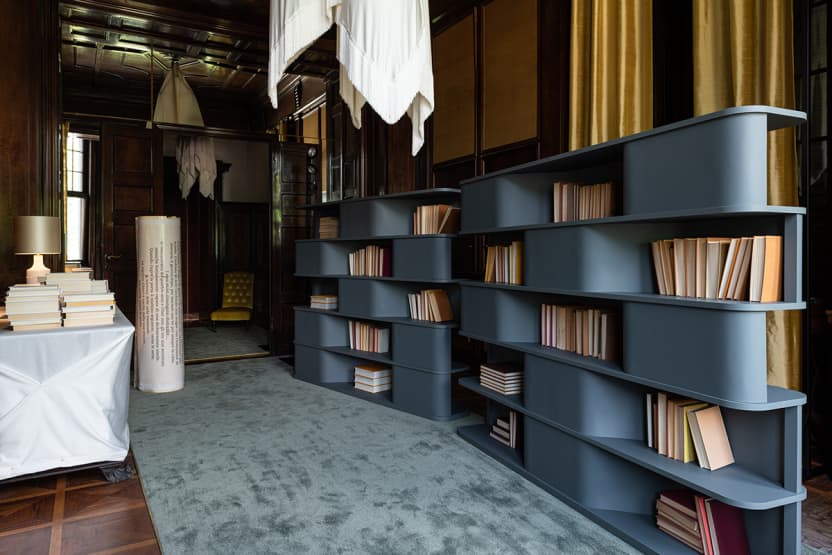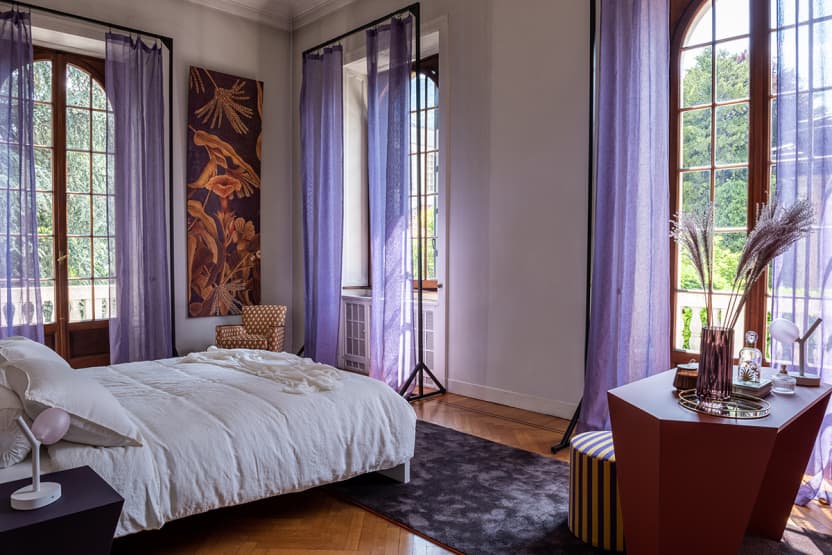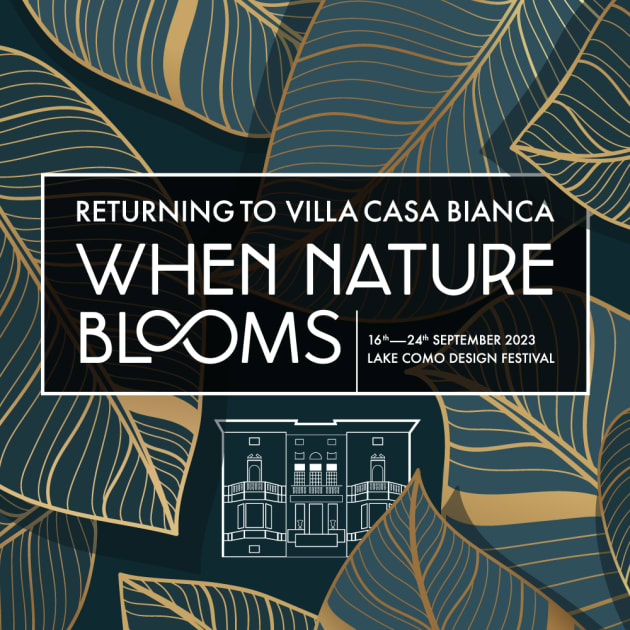
Returning to Villa Casa Bianca
Designed by the Dutch architects Van Beek en Dings in collaboration with Musa, “Returning to Villa Casa Bianca” is a temporary project inside a long-uninhabited residence on Lake Como. FENIX®, Arpa®, Getacore®, Homapal®, Formica® and Westag Türen® – all belonging to Broadview, the leading global group in material technology – show new perspectives on surface design. The set-up enhances the concept of forward integration, creating synergies between the group’s different materials, iconic design elements and green life. During Lake Como Design Festival, the project hosts “When Nature Blooms” installation by the Italian flower designer Letizia Dei Fiori.
Villa Casa Bianca
Standing out on Lake Como promenade with its distinctive white architecture, Villa Casa Bianca was developed by engineer Carlo Ponci in 1920s. Characterised by Art Déco style, with typical bow-windows and white marble from local quarries, the villa presents a hospitality ground floor and a noble first floor. Over the decades, it underwent several transformations seeing, for example, the alternation of wood and terrazzo flooring, popular in the ‘40s-50s design culture. In those same years, architect Luigi Caccia Dominioni, considered a great master by Milanese high bourgeoisie, created different elements for the villa, including the original lamps.
The story behind the project
In “Returning to Villa Casa Bianca”, visitors identify with the family owner that, after many years around the world, returns to the residence. Entering, they see the passing of time in some imperfections, while being surprised by the beauty of combinations between travel memorabilia and the villa’s new furniture. In dialogue with different styles, from antique furniture pieces to Arabic and Asian influences, contemporary creations made with the group’s materials also connect with nature through a harmonious narrative. “When Nature Blooms” imagines nature bursting into the villa’s rooms in the absence of its owners: plants and flowers sprout day after day, decorating and becoming integral part of domestic spaces.
The Hall
In Art Nouveau style, where the parquet’s decorations dialogue with the draperies of wallpaper, the hall shows fabrics covering up the lamps and chairs. Preventing objects from being damaged while the family was abroad, the fabrics create invisible elements as a representation of their leaving, in contrast with new visible furniture speaking of their return. With Formica light green top and Homapal golden sides, two pedestals supporting plants live in combination with the central table. The latter shows the same Formica tone with matched colour core for the top and Homapal stand.

The Library
The wood characterises the boiserie, ceiling and parquet. Walls reveal traditional silk panels – a Como historical manufacture – whose imperfections reflect the passing of time, are in dialogue with the curtains’ contemporary silk texture. As part of “Futuro Composto” *, a modular library made of FENIX Verde Comodoro shows the innovative materials’ bending possibility and extremely matt colour. The books, unexpectedly showing their fore-edge, recall the warm tone of silk and of Caccia Dominioni’s lamps, giving a sense of intimacy by maintaining the secretness about the family’s reading.
* Futuro Composto is a workshop conceived by architect Lorenzo Palmeri for FENIX which includes “Hive” the bookshelf designed by Lucia Galiotto.

The Hallway
An immersive experience of X-KIN by FENIX opens in the hallway. The adaptable surface material is applied on walls and ceiling in Rosso Jaipur Brina Limited Edition, presenting a touch of gloss on the matt surface. X-KIN here shows an original solution by being framed with trimming. The red tone extends through the veins of the terrazzo floor, that reflects the ‘50s style introduced by architect Carlo Scarpa. The green and gold speckles of the floor match with two obelisks made of Formica Cora, recalling a trip to Egypt. The FENIX door, part of Westag Türen collection, follows this chromatic continuity by showing Rosso Jaipur on one side and Verde Comodoro on the other.

The Staircase
In the lobby leading to the grand staircase designed by Caccia Dominioni, an arcade has been crated to enclose two FENIX DOORS by Westag Türen: one in Oro Cortez and the other in Verde Comodoro. The marble staircase is complemented with a sunscreen structure reminiscing the Morrocan architecture faces the back garden. Developed during “Futuro Composto” * in FENIX Rosso Jaipur, this Moresque-like window creates a suggestive play of contrasts between the material’s low light reflectivity and the daylight passing through.
* Futuro Composto is a workshop conceived by architect Lorenzo Palmeri for FENIX which includes “Mashrabiyya” the window panel designed by Laura Tardella.

The Transition Room
With Getacore diamond-effect top combined with Homapal sides in Antique Rubbed décor involving handwork interventions, the settles represent the villa’s collector of memories. Next to them, FENIX Verde Kitami poufs with salmon-coloured cushions are matched with the pink nuance of the carpet. Here nature is on stage both physically with majestic plants and visually with floral prints that play homage to the encyclopaedia “Naturalis Historia” by Plinio the Elder, theme of Lake Como Design Festival.

The Living Room
Window-arcades welcome visitors in the living room creating mesmerizing postcards from the lake. The setting blends the elegance of surface design with selected furniture pieces and inspiring fabrics. On a FENIX Blu Fes coffee table, an aquamarine cushion matches with the armchair and sofa. A low cabinet combines FENIX Nero Ingo top with doors in Tuet, Arpa’s Deep Surface, in wood décor Caravella Dark. As a souvenir from a visit in local manufacturers of Bangkok, flamboyant curtains frame the windows. Designed by a traditional Italian manufacturer, one of the sofa cushions also shows an eye-catching pattern that underlines the accuracy of details and slow production.

The Kitchen
Complying with the contemporary trend of wide kitchen design and valuing the concept of perfect imperfections, the kitchen space reflects the sense of sharing and conviviality. The yellow of Formica drawers and cabinets recall the colour below the ceiling paint, showing the durability of the group's materials in contrast with the villa's signs of aging. FENIX Nero Ingo kitchen tops - revealing the material's integrated solution of the sink in flushmount version – dialogue with the splashback in Homapal Alu Cella Black. Meanwhile, linear elements connect with each other, including lamp and low table made in Formica Cora, FENIX Verde Kitami counter and La Palma’s Lem stools in FENIX Bianco Kos.

The Dining Room
In a refined mix of contemporary, pop and neoclassical suggestions, the dining room represents the high bourgeoisie pleasure of balancing different aesthetic references. 70s-inpired denim chairs surround the room’s protagonist: an oval table that plays with fishbone inlays alternating two FENIX new tones. Blu Shaba and Grigio Aragona align both with the floor’s and the lake’s nuances. Above the table, an iconic lamp guides the eye from a Piranesi-styled print portraying a Tuscan landscape to the Formica combination of pop pattern shelves and classic bench made of Cora.

The Bathroom
Water and circularity are protagonists of the bathroom design. In the original material context of marble flooring, crafted windows and early-century taps, the group’s surfaces offer a charming renovation. Homapal Lava texture, providing the vanity backwall with reflective golden waves, matches with Getacore yellow sink that embraces the environment with a visual softness. As a harmonious flow, this metallic-warm bond accompanies the circular geometry of mirror, bowl lamp, window and architectural arches.

The Bedroom
The luminous bedroom, surrounded by windows facing the balconies, enlightens different chromatic and space levels. The unexpected play of complementary tones of FENIX Viola Orissa and Rosso Namib, respectively applied to the bedside tables and the vanity desk, is enhanced by the yellow touch of fabrics among seats and floral wallpaper. The bedhead – in Homapal Alu Mesh and FENIX Viola Orissa inlays – reveals a second background with the cabinet behind. With an intriguing work of Tuet by Arpa, the cabinet shows the ribbed deep surface in a rhomboid composition recalling the armchair’s pattern and the door’s original decorations.

The Lounge
Making nature protagonist with large vases of palms, the lounge’s pedestal shows Getacore diamond-effect top combined with Homapal sides in Antique Rubbed décor that involve handwork interventions. “Futuro Composto”* created a serpentine bench, consisting of modular seats able to shape both linear and curved design compositions. Made of FENIX Grigio Efeso, it enhances the concept of versatility of the exhibition. On the wall the natural presence returns with Asian floral prints, bringing to the family’s villa a tale about their Far East travel.
* Futuro Composto is a workshop conceived by architect Lorenzo Palmeri for FENIX which includes “X-Rail” the modular seat system by Anna Bissoli.

The Studio
The dark wood of the studio’s bow-windows and ceiling embraces a blend of different design elements: from Caccia Dominioni’s bowl lamps to zoomorphic ceramics by the pop designer Elena Salmistraro to furniture made with the group’s surfaces. An elegant maximalism balanced by chromatic harmony. FENIX Nero Ingo characterises Italian manufacturer De Padova’s revisitation of Vico Magistretti’s Shine round table and the standing lamp’s legs by German brand Balada, while the new Giallo Evora of the studio desk is enhanced by dark surrounding elements. Aside, a cabinet made of Formica Laminate Fir adds naturalness to the space with a deep green nuance, that matches with the soft earth tone of the carpet.





